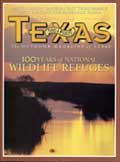
Wild About Rice
By Jennifer Nalewicki
Time may be running out for a precious grain.
Standing in waist-deep water in the San Marcos River, Erin Gregorcyk measures the length, width and height of plants whose thin, elongated leaves float lazily before her, at times sticking to her skin. She and 10 other volunteers are working with Texas wild rice, Zizania texana, a relative of the wild rice grown for human consumption. The Texas version, once so abundant it was considered a nuisance, has become one of the state’s most vulnerable endangered species.
Gregorcyk, a volunteer lab technician for the Texas Parks and Wildlife Department and a student at Texas State University-San Marcos, is helping research a 4-mile-long stretch of the San Marcos River that harbors the last remaining stands of Texas wild rice. About 250 stands are left, covering roughly 6,200 square feet. So little of it is left because it grows only where the water is crystal-clear and fast-flowing and stays at a constant temperature year-round.
“I know people at school who wonder why nobody cleans out all of the plants from the river,” Gregorcyk says. “They don’t realize that this is the only spot in the world where Texas wild rice grows.” During the 1930s people saw the plant as problematic, since its leaves would constantly clog up ditches, according to reports made by the local irrigation company at the time.
Today, information kiosks along the river inform the public how close the species is to extinction. Almost anything that can go on in the river can affect Texas wild rice. Pumping groundwater from the Edwards Aquifer for agricultural and human consumption endangers the volume and clarity of the river flow. Swimmers and paddlers sometimes uproot the plant, taking a further toll on it.
That is why TPWD botanist Jackie Poole, with the help of volunteers from agencies such as the TPWD, the U.S. Fish and Wildlife Service, Texas Department of Transportation and the City of San Marcos, spent a week last summer measuring the plant’s growth. By estimating the percentage cover of each stand and comparing the numbers to those of previous years (as far back as 1989, when the monitoring began) Poole can better understand what the species’ odds of survival are and what steps should be taken to help with its future.
It will take months before Poole can come to any conclusions as to how much has been lost and how much new rice has grown back. However, she says that researchers found several new plants this summer, and that in the past the population increased in areas upriver, near the campus, and decreased below Interstate 35, because of pollution and flooding.
Poole says that the species’ future doesn’t look very good. “I think there’s a good possibility of extinction in the wild,” she says. “If it came down to humans versus Texas wild rice, the rice would lose.”

